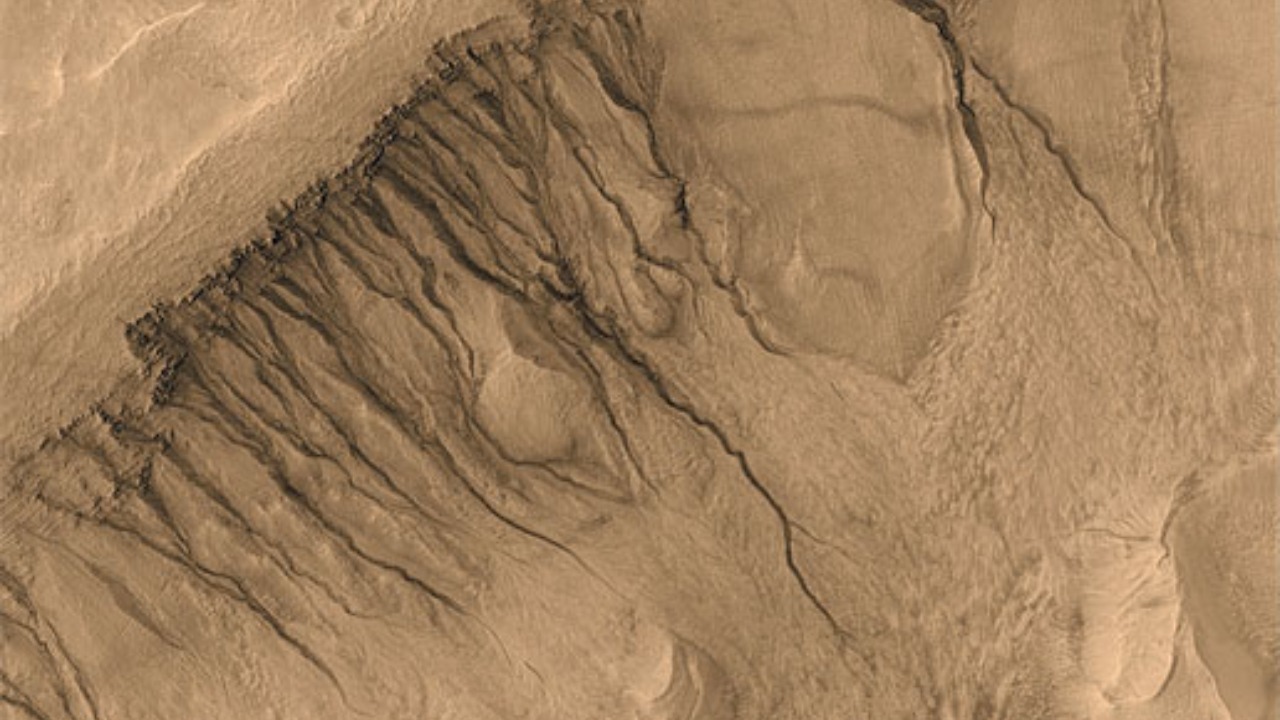
Mysterious gullies on the surface of Mars, long puzzling scientists, appear to have been carved by burrowing blocks of CO₂ ice, according to a recent study that describes this mechanism as an “explosive” revelation in planetary geology. This hypothesis, detailed in reporting from October 14, 2025, suggests that the ice blocks move and erode the Martian terrain in a dynamic, self-propelled way. Further coverage on October 16, 2025, emphasizes the explosive nature of this answer, potentially reshaping understandings of Mars’ recent geological activity (Phys.org).
The Enigma of Mars’ Gullies
The gullies on Mars, primarily located in mid-latitude craters and alcoves, have intrigued scientists for years. These features are characterized by their narrow channels and fan-shaped deposits, which suggest a process of erosion and deposition. Recent analyses have highlighted their presence in specific regions, indicating a pattern that might be linked to seasonal changes on the planet (Phys.org).
Observations of these gullies reveal signs of relatively recent activity, contrasting with the ancient landscapes that dominate much of Mars. This freshness suggests ongoing processes that continue to shape the Martian surface, making the gullies a focal point for understanding the planet’s current geological dynamics. The timeline of their formation remains a subject of intense study, as researchers strive to pinpoint the exact mechanisms at play (ScienceDaily).
Initially, the origins of these gullies baffled researchers, who struggled to reconcile their existence with known Martian conditions. The mystery of their formation has persisted, driving numerous studies and hypotheses aimed at uncovering the forces behind these intriguing features. Understanding the gullies is crucial not only for planetary science but also for broader explorations of Mars’ past and present environments (Phys.org).
Challenging Past Theories
Previous theories about the formation of Martian gullies often centered on water-based erosion models. These models suggested that liquid water, despite Mars’ cold and arid environment, might have flowed across the surface, carving the gullies. However, the presence of liquid water in such conditions remains highly speculative, challenging the viability of these models (ScienceDaily).
Alternative hypotheses proposed that dry landslides or rockfalls could explain the gullies, avoiding the need for water. While these theories accounted for some aspects of the gully shapes, they failed to fully explain the observed freshness and distribution of these features. The limitations of these models highlighted the need for a new perspective that could better align with the available data (Phys.org).
The inconsistencies in past theories, particularly regarding the freshness and specific morphologies of the gullies, underscored the necessity for a more comprehensive explanation. This gap in understanding set the stage for the recent breakthrough involving CO₂ ice, which offers a novel and compelling mechanism for gully formation on Mars (ScienceDaily).
The CO₂ Ice Burrowing Mechanism
The new hypothesis proposes that blocks of CO₂ ice form and begin burrowing into Martian slopes, driven by sublimation and gas pressure in the seasonal ice caps. As the CO₂ ice sublimates, it creates a cushion of gas that propels the ice blocks downhill, carving channels into the Martian surface. This process is described as “explosive” due to the rapid and forceful movement of the ice, which can significantly alter the landscape (Phys.org).
The propulsion of these ice blocks is self-sustaining, as the trapped gases continue to drive the movement, allowing the ice to erode and transport material as it moves. This dynamic process not only explains the formation of the gullies but also aligns with the observed freshness and distribution of these features. As the ice blocks gradually melt or sublimate, they leave behind the characteristic channels and deposits that define the Martian gullies (ScienceDaily).
Evidence from Martian Observations
Imagery and data from Mars rovers and orbiters have provided crucial evidence supporting the CO₂ ice burrowing hypothesis. These observations show gully features that align with CO₂ ice deposit patterns during the Martian winter seasons, suggesting a strong correlation between the ice activity and gully formation. The visual data offers compelling support for the idea that CO₂ ice plays a significant role in shaping these features (ScienceDaily).
Laboratory simulations and modeling have further bolstered this hypothesis by replicating the burrowing process under Mars-like conditions of low pressure and cold temperatures. These experiments demonstrate how CO₂ ice can move and erode material in a manner consistent with the observed Martian gullies. The ability to recreate these processes in controlled settings provides a strong validation of the proposed mechanism (Phys.org).
Comparisons between gully morphologies and predicted outcomes from CO₂ ice movement reveal matches in channel widths and alcove shapes. These similarities reinforce the idea that CO₂ ice is a key driver of gully formation, offering a coherent explanation that integrates both observational and experimental data. The alignment of these findings with the proposed mechanism marks a significant advancement in understanding Martian geology (ScienceDaily).
Implications for Mars Science
This discovery of CO₂ ice-driven gully formation indicates ongoing geological activity on Mars, driven by seasonal CO₂ cycles rather than ancient water flows. This insight reshapes our understanding of the planet’s climate and geological history, suggesting that Mars is more dynamically active than previously thought. The implications extend to broader studies of Martian climate and the potential for transient ice features elsewhere on the planet (Phys.org).
The findings also open new avenues for future missions to Mars, which could focus on testing the burrowing hypothesis through targeted imaging of active gully sites. Such missions would provide further data to refine our understanding of Martian geology and the processes that continue to shape its surface. The potential for discovering more about Mars’ climate and geological activity makes this an exciting area of exploration for scientists and space agencies alike (ScienceDaily).